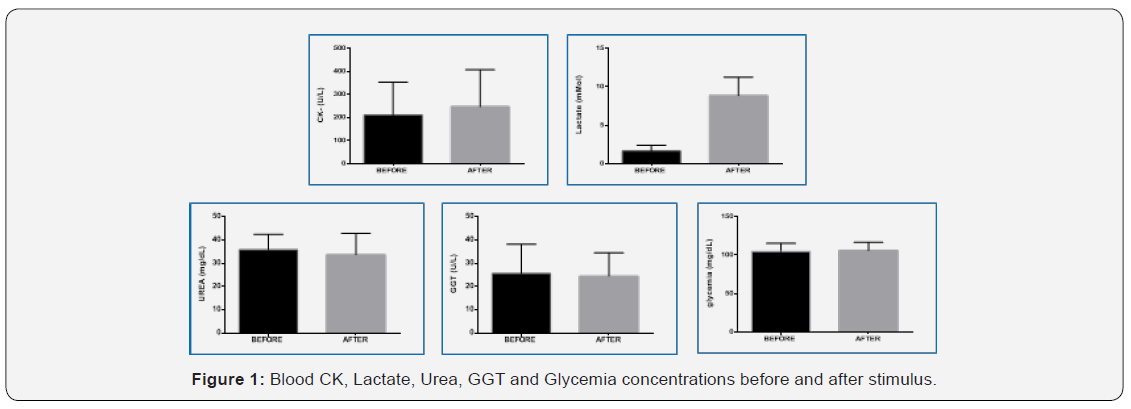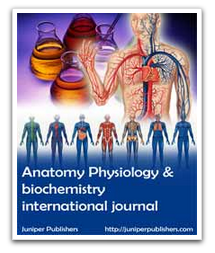Anatomy Physiology & Biochemistry - Juniper Publishers
Abstract
HIIT - sprint training can help all runners? Can all runners do the same training for better pace? This study examined blood Concentrations of CK, Urea, Gama Glutamyl Trasferase, GLycemia and Lactato before and after jump test (Bosco et. al), included twenty amateur runners. Blood samples were collected from the fingertip for [La-] assessment before and 1min after jumps test using aportable analyser (Lactate Plus®, Waltham, MA 02454-9141, EUA) and Reflotron Plus® (Roche) for the measure the other parameters, before and after 10 minutes. Jump performance were evaluated using CEFISE® Optical plataform and during one minute using counter moviment jump (CMJ). The main Result were acutely great heterogeneity for muscle damage (CK) before 30~472 after 64~476, power indicated by the [La-] (internal load) before 0.8~3.2 after 3.8~12.8, and power by the platform of jumps (external load) 968~1583 Watts. The elevated capacity to produce power by some runners and the inabili ty of others also possible to observe and high (La-) values after test confirms the transition from energy sources (aerobic to lactic anaerobic). The study suggest that biomarkers, especially the lactate (confirmed by the jumping platform) allow to identify the runners that have the greatest capacity to produce power and then optimize their performance with HIIT (sprints training), however the runners that do not have this characteristic need other strategies, example, continuous training. In this way the training can be totally individualized, optimized the chances of success of the program and with great safety related to the health of the runners.
Keywords: Biomarkers; Optimal training; Internal loads; Runners
Abbrevations: HIIT: High-Intensity Intervalmittent Training; CK: Creatine Kinase; GGT: Gama Glutamyl Transferase; UR: Urea; [La-]: Blood Lactate Concentrations; CG: Capillary Glycemia; (mmol.l-1) – Millimole/liter, Min - Minute
Introduction
Nowadays there is a growing number of amateur runners becoming involved in competitions around the world. Runners essentially pursue two objectives: First to improve their athletic performances and second to be healthy enough to keep training and achieving their aims [1]. However despite being subjected to loads and high training volumes, little is done to individualize and professionalize prescriptions and planning. This can lead to an increase in the number of injuries and/or loss of performance. Recent reviews have highlighted the potential of varying quantities of both high-intensity intervalmittent training (HIIT) and continuous high-volume, low-intensity training on performance in athletes. [2,3] there is no doubt that both types of training can effectively improve cardiac and skeletal muscle metabolic function [4,5]. The key question is: what is the optimal dosage of both types of training for an individualized program, respecting the genetic characteristics (types of muscle fibers for example) and the adaptations generated by sports experiences and the epigenetic? How much will perturb the running kinematics [6,7], oxidative stress levels and the inflammation the runners (amateurs) using the HIIT more intense than your limits [8,9]? The use of biomarkers of acute phase, mainly to define optimal intensities and volumes during specific training and some competitions; the use external loads always associated with internal loads; the establishing an individualized database of each athlete for future decision making based on individuality may favor better performance and avoid illness sports-related, such as ITRS (upper respiratory tract infections) and immunosuppression [9-11]. For example the Lactate, that is the end product of the anaerobic metabolism, diffusing from the muscle cell into the bloodstream when aerobic and other metabolic pathways are unable to keep up with the removal of pyruvate, can sinalize limites very interesting with foccus in training control and optimal loads [12-14]. Chronically elevated CK may indicate insufficient recovery. Because other components of muscle such as myoglobin may leak into circulation during muscle damage (peak 1-3 hours after exercise), and urea nitrogen can indicate overall protein synthesis vs. breakdown [15]. Monitoring the application of training loads will bring important information to the staff: Exercises; Methods of implementation; Volume in repetitions and series; Proposed intervals; Distribution density of the blocks; Technical execution quality associated with metabolic demands; Recovery time; Physiological impact of the activities proposed in the training cycles [16].
Methods
Ethics
This study was approved by the Ethical Committee of the University of Vila Velha n˚ 2.373.739/2017). All individuals were informed about the possible risks and benefits of the study, and agreed to participate and signed the informed consent form. CAAE 78770017.0.0000.5064.
Subjects
Twenty (20) men (runners amateur) volunteered to participate in the current study and signed an informed consent form. Their mean ± SD main body characteristics were: 38±16 years of age, 71.2±13.7 kg of body mass, 172.0±5 cm of body height, 13± 5.2% of fat mass. The body characteristics assessment was conducted before the beginning of the experimental protocol, with body mass and fat mass measured using the protocol sum of seven skin folds [17]. All without diagnosed diseases and without the use of medication.
Protocols
The blood samples were collected from the fingertip for [La] assessment before and 1min after jumps test using aportable analyser (Lactate Plus®, Waltham, MA 02454-9141, EUA) and Reflotron Plus® (Roche) for the measure the other parameters (CK, GGT, UREA and CG) before and after10 minutes of the jumps test. After the warm-up (10 min–bicycle ergometer) all runners were submitted to a test protocol used to measure anaerobic power-Bosco et al. [18], using CEFISE® Optical jumping platform, protocol COUNTER MOVEMENT JUMP(CMJ), this is performed standing with straight legs and performing a jump beginning with a counter movement down to a knee angle of 90 degrees. The hands are held on the hips during the jump to avoid any effect of arm-swing.
Result and Discussion
In Table 1 it is described the individual and mean ± SD values corresponding of [La-] and CK before and after test, as well as number of jumps and Power (Watts). It was possible verify acutely great heterogeneity for muscle damage (CK), power indicated by the [La-] (internal load) and watts by the platform of jumps (external load). At this point we can infer about the capacity to produce power by some runners and the inability of others. Also, it is possible to observe high (La-) values after test which confirms the transition from energy sources (aerobic to lactic anaerobic) [19]. According to Figure 1, we checked CG for pre-test condition and post-test counterregulatory hormones, UR for overall protein synthesis vs. breakdown, GGT an oxidative stress marker and and systemic inflammation presented similar behavior indicating low overload levels [20]. It is important to refer that aaccording study with handball players who analyzed the anaerobic parameters (maximum Power, average, minimum, and fatigue indices) obtained in RAST (Running Based Anaerobic Sprint Test), as well as check the correlations between the variables obtained in RAST tests with those obtained in platform jumps (BOSCO et. al.) power can be measured in sprints or jumps [21-22].


Conclusion
The study demonstrated that biomarkers, especially the lactate (confirmed by the jumping platform) allow to identify the runners that have the greatest capacity to produce power and then to maximize their performance with HIIT (sprints training), however the runners that do not have this characteristic (power production) need other strategies by the staff. It is worth mentioning that strength is a precursor of power, and it may be one of the strategies to increase the strength levels, of the runners, before HIIT (sprints training) together continuous training. Lastly given the importance that exercise biochemistry and physiology has for science of sports training, coaches and researchers should have a clear understanding the contribution about the use of biomarkers on search ideal training [23-30].
Click here: https://juniperpublishers.com/index.php





No comments:
Post a Comment